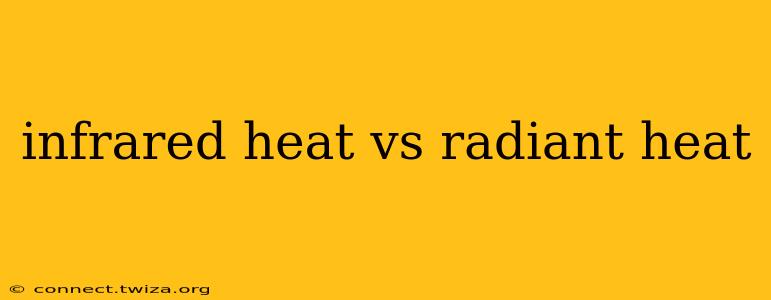The terms "infrared heat" and "radiant heat" are often used interchangeably, leading to confusion. While closely related, there's a subtle but important distinction. This article will clarify the difference, explore their applications, and answer frequently asked questions.
What is Radiant Heat?
Radiant heat is a form of energy transfer that involves the emission of electromagnetic waves. These waves travel in straight lines and don't require a medium (like air or water) to transfer heat. When these waves strike an object, they are absorbed, causing the object's molecules to vibrate and increase in temperature. Think of the sun warming your skin – that's radiant heat in action. Many different types of electromagnetic radiation transfer heat radiantly, including infrared radiation.
What is Infrared Heat?
Infrared (IR) radiation is a type of electromagnetic radiation that falls within a specific wavelength range on the electromagnetic spectrum, longer than visible light but shorter than microwaves. It's a crucial part of the radiant heat spectrum, meaning infrared heat is a form of radiant heat. However, not all radiant heat is infrared. For example, visible light also transmits heat radiantly.
So, what's the difference? The key takeaway: Radiant heat is the broader term encompassing all forms of heat transfer via electromagnetic waves. Infrared heat is a specific type of radiant heat, defined by its wavelength. Think of it like this: all squares are rectangles, but not all rectangles are squares.
Frequently Asked Questions (PAA)
Here are some common questions surrounding infrared and radiant heat, answered comprehensively:
What are the different types of radiant heating systems?
Several systems utilize radiant heat:
- Electric radiant heating: This uses electric resistance elements to generate infrared heat, often found in underfloor heating systems, electric panels, and some ceiling systems.
- Hydronic radiant heating: This involves circulating hot water through pipes embedded in floors, walls, or ceilings. While the heat transfer method is primarily conduction, the resulting heat is radiated into the room.
- Gas radiant heating: Gas-fired heaters directly produce infrared radiation, commonly seen in outdoor patio heaters.
- Solar radiant heating: This leverages the sun's radiant energy, predominantly infrared, to heat a space passively.
How does infrared heat work?
Infrared heat works by emitting infrared radiation. When this radiation hits an object (like a person or a wall), it's absorbed, increasing the object's temperature. Unlike convection heating (heating the air), infrared heating directly heats surfaces, which then radiate heat into the surrounding space.
Is infrared heat harmful?
In general, exposure to low levels of infrared radiation, such as from standard household infrared heaters, is not considered harmful. However, very high levels of infrared radiation can cause burns. Most commercially available infrared heaters are designed to operate within safe ranges.
What are the advantages of infrared heating?
- Direct heating: It efficiently warms objects and people directly, rather than heating the air first.
- Energy efficiency: Because it's more targeted, less energy is wasted heating unoccupied space.
- Comfort: Many find infrared heating more comfortable because it doesn't dry out the air as much as convection heating.
- Quiet operation: Infrared heaters are usually silent.
What are the disadvantages of infrared heating?
- Uneven heating: If not properly installed, it can create hot spots.
- Initial cost: Infrared heating systems can have higher initial installation costs.
- Potential for burns: While safe under normal operation, direct exposure to powerful infrared heaters can cause burns.
- Line of sight: Infrared heaters only heat objects directly within their line of sight. Obstructions can hinder heat transfer.
Which is better: infrared or convection heating?
The "better" choice depends on individual needs and preferences. Infrared heating offers targeted, energy-efficient warmth, making it comfortable and potentially more cost-effective in the long run. Convection heating is typically less expensive initially but may use more energy overall.
This exploration aims to provide a detailed, accurate, and user-friendly explanation of the differences and similarities between infrared and radiant heat. Remember, infrared heat is a type of radiant heat, but radiant heat encompasses a broader range of heat transfer methods.
